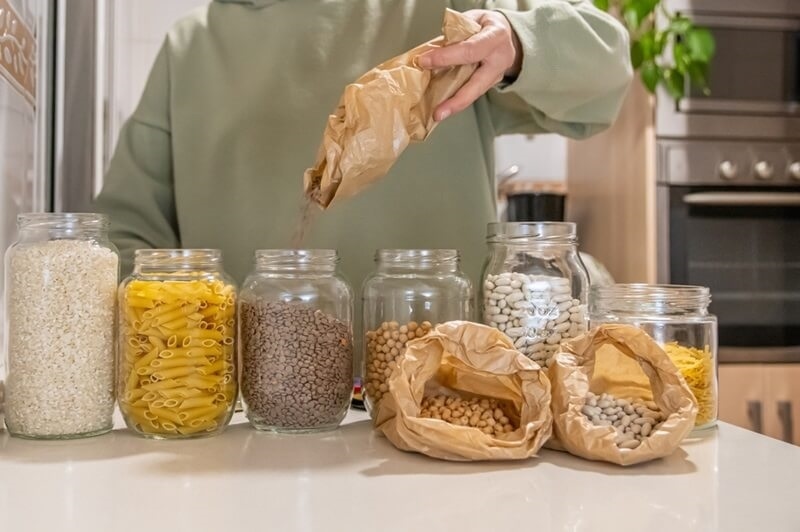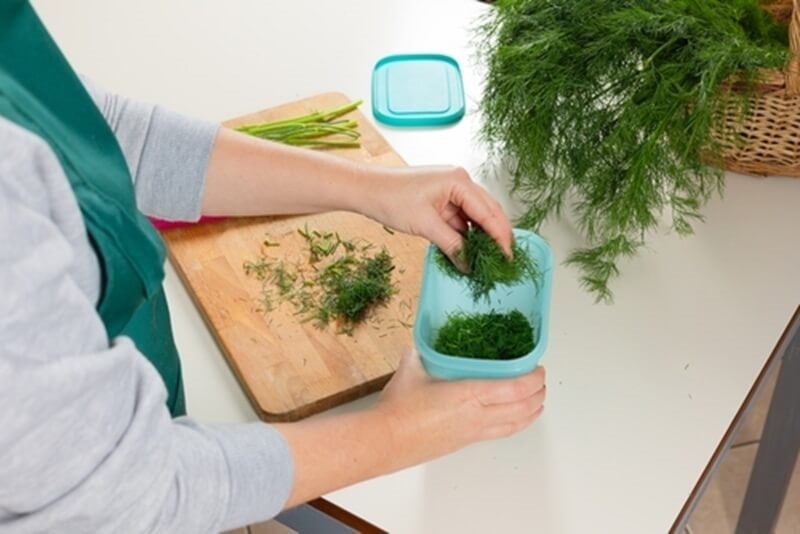
Let’s be honest — we’ve all opened the fridge to find slimy spinach, a half-cut lemon that’s dried out, or leftovers we swore we’d eat but never did. It happens. The truth is, most of us waste more food than we realize simply because we don’t store it right. The good news? A few simple food storage hacks can completely change that. Think of this as your no-nonsense guide to keeping groceries fresh, reducing waste, and actually saving money — without turning your kitchen into a science lab.
Before diving into tricks, it helps to understand why food goes bad. Every item in your kitchen reacts differently to temperature, moisture, and air. Lettuce wilts because it’s exposed to too much humidity. Bread molds because it’s sealed tight. Apples make nearby fruits ripen (and rot) faster due to ethylene gas. Once you know what causes the problem, you can store things smarter — not harder.
Let’s start with the basics — small tweaks that make a huge difference. These food storage hacks aren’t about fancy containers or gadgets; they’re about habits. For example, wrap leafy greens in paper towels before sealing them in a bag. The towel absorbs moisture, keeping greens crisp. Store berries in a paper-lined container with the lid slightly open. It prevents mold and extends their life by days.
Another easy win? Don’t wash fruits and veggies until you’re ready to eat them. Washing introduces moisture, which speeds up spoilage. Keep them dry and cool instead.
The fridge isn’t just a cold box — it’s a system. And understanding how to use it is half the battle. Most fridges have temperature “zones.” The back and bottom shelves are the coldest, perfect for raw meat and dairy. The upper shelves stay slightly warmer, ideal for leftovers and drinks. The crisper drawers are designed to control humidity for produce.
Follow these fridge organization tips to make the most of that space:
A clean, organized fridge doesn’t just look satisfying — it also saves money because you’re less likely to forget things hiding in the back.

If you’ve ever bought fresh cilantro or basil, you know how frustrating it is when they wilt after a day or two. Luckily, storing herbs and greens the right way can easily double their life span. Treat them like flowers. Trim the stems, place them in a jar with a little water, and loosely cover with a plastic bag. Keep them in the fridge — except for basil, which prefers room temperature.
For greens like spinach, kale, or lettuce, wash and dry them completely. Then wrap in paper towels before sealing them in an airtight bag or container. The paper soaks up any lingering moisture and keeps them crisp. It’s one of those small kitchen rituals that feels oddly satisfying once you get into the habit.
We all have that moment — standing in front of the fridge wondering if we’ll actually eat last night’s pasta before it goes bad. Here’s a better plan: freeze it. Learning freezing leftovers the right way can save both time and effort. The trick is portioning and labeling. Don’t dump everything into one big container. Divide it into meal-sized portions, cool completely, then seal tightly to avoid freezer burn.
Use freezer-safe bags and lay them flat so they stack easily. When you’re ready to reheat, thaw overnight in the fridge instead of blasting it in the microwave from frozen. This keeps the texture closer to freshly cooked. And don’t forget soups, stews, and curries — they actually taste better the next day (or week).
A few simple habits go a long way in prolonging food shelf life. For instance, store onions and potatoes separately — together they make each other spoil faster. Keep apples away from bananas, unless you want your bananas to ripen overnight. And always rotate older items to the front when unpacking new groceries.
Eggs? Keep them in their original carton, not the fridge door, where temperature fluctuates every time you open it. Bread lasts longer at room temperature in a bread box, not in the fridge where it dries out. Cheese should be wrapped in wax paper, not plastic, so it can breathe. Once you know these patterns, you’ll find your food simply lasts longer without effort.
Your freezer is a secret weapon — not just for ice cream and frozen peas. It can be a storage hero. Herbs about to go bad? Chop them, place them in ice cube trays, cover with olive oil, and freeze. You’ll have ready-to-use flavor bombs for cooking later. Same with tomato paste — no more wasted half cans.
Bread, cooked rice, even grated cheese freeze beautifully if stored right. Label everything with dates so you know what’s oldest. A freezer that’s full (but not overpacked) actually works more efficiently, so fill it smartly.
Here’s where all these tricks tie together — how to avoid food wastage. It’s not just about saving money; it’s about mindfulness. Plan your meals before shopping. Use what’s already in your fridge before buying more. Turn slightly wilted vegetables into soup or stir-fry. Freeze fruit that’s getting soft for smoothies later.
Even small changes help. Store sauces in squeezable bottles to minimize waste. Keep a “use first” bin in your fridge for items nearing their limit. You’ll be amazed how much less you throw away when you can actually see what needs attention.
This one’s underrated. Label everything — from leftovers to freezer bags to pantry jars. Include what it is and the date. You think you’ll remember when you made that curry, but you won’t. Labels make it easy to spot what needs to go first, cutting down on forgotten food.
If you’re feeling fancy, use color-coded stickers: green for fresh, yellow for “use soon,” red for “freeze me.” It’s a small step, but it turns chaos into clarity.
Not everything belongs in the fridge. Dry goods like flour, pasta, and grains do better in airtight jars or containers. This keeps out moisture and pests. Nuts, seeds, and coffee beans, however, last longer in the fridge because their oils can go rancid.
Organize your pantry by type — grains in one area, baking supplies in another. Rotate older stock to the front. And if you love snacking, keep those items at eye level to prevent tearing apart the shelves every time you crave something crunchy.
Sometimes old-fashioned solutions are the best. Vinegar and baking soda aren’t just for cleaning; they’re secret food savers too. Soak berries in a diluted vinegar bath (1 part vinegar to 3 parts water) before drying them. It kills mold spores and extends freshness.
Slip a box of baking soda into your fridge or freezer to absorb odors and moisture. It’s cheap, simple, and effective — basically everything modern gadgets try to be.
You don’t need to buy expensive storage sets. Glass jars, old sauce bottles, or even yogurt tubs can be repurposed. They’re perfect for storing small portions, sauces, and snacks. Transparent containers help you see what’s inside — no more mystery leftovers.
Also, stack smartly. Heavier items go at the bottom, lighter ones on top. Leave some room for airflow so the fridge or freezer can work efficiently. You’ll not only save space but also reduce clutter, making meal prep feel smoother.
A common mistake people make? Storing milk or eggs in the fridge door. It’s the warmest spot, thanks to constant opening and closing. Use it for condiments, juices, or butter instead. For longer-lasting dairy, keep it on a middle or lower shelf where it stays cold and stable.
A small tweak, but it makes a surprising difference in freshness.
Don’t just reheat leftovers — reinvent them. That roasted chicken can become a sandwich, soup, or salad topping. Extra rice can turn into fried rice or pudding. Leftover mashed potatoes? Mix with flour and cheese to make quick fritters. When you start viewing leftovers as ingredients instead of leftovers, you’ll never run out of ideas — or waste.
Like anything else, keeping food fresh is about building habits. Dedicate 10 minutes each week to sorting the fridge, checking dates, and rotating food. Wipe shelves, replace paper towels under produce, and freeze what you won’t eat soon. It’s not glamorous, but it’s deeply satisfying — like hitting “reset” on your kitchen.
Fresh food doesn’t have to be a luxury. With these food storage hacks, you can make your groceries last longer, your meals taste better, and your wallet stay happier. A little effort — wrapping herbs correctly, practicing fridge organization tips, and mastering freezing leftovers — pays off big. From storing herbs and greens to prolonging food shelf life, these small changes add up to something bigger: less waste and more mindfulness.
So, the next time you unpack your groceries, don’t just shove everything in. Take a few minutes to store them right. You’ll thank yourself days later when your lettuce is still crisp, your berries are still fresh, and your fridge actually makes sense. Because a well-kept kitchen isn’t just tidy — it’s a quiet, everyday win.
This content was created by AI